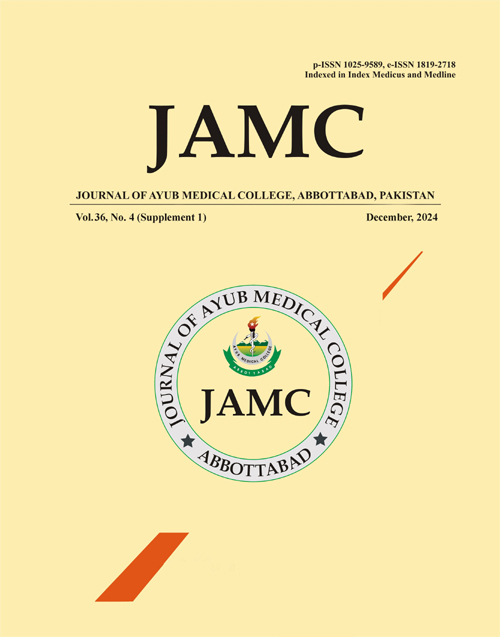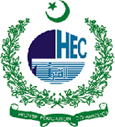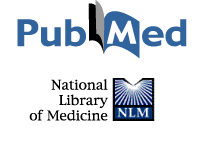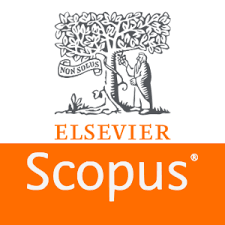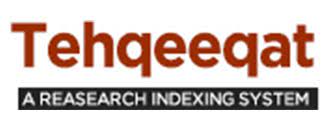EXHUMATION: SOLVING MYSTERIES IN THE ABSENCE OF INITIAL POSTMORTEM
DOI:
https://doi.org/10.55519/JAMC-S4-14755Keywords:
Exhumation; Postmortem; Forensic investigationsAbstract
Background: Stories of lives lived, unsolved mysteries, and undiscovered history are all hidden beneath the surface of the ground. Exhuming human remains is a voyage into the core of human existence, where the buried whisper their truths to the present. It is more than just a scientific procedure. This study was conducted to assess the reason of exhumation in cases where the initial postmortem was not performed. Methods: This retrospective study was conducted from August 2021 to August 2024. A total of 27 cases were studied at Ayub Teaching Hospital and Benazir Bhutto Shaheed Hospital, Abbottabad, under the supervision of the Forensic Medicine Department, Ayub Medical College. Data were collected and analyzed using Microsoft Excel. The findings were tabulated as frequencies and percentages. Result: Among 27 autopsy cases, the majority involved individuals aged 21–30 years. Most of the autopsies were of male. Determining the cause of death was the primary reason (47%), while the absence of an initial postmortem accounted for 19% of cases, highlighting procedural gaps. Three out of nine cases were confirmed as a natural death, while the remaining six involved unnatural causes. Conclusion: Exhumation serves as a vital tool in forensic investigations, particularly in cases where initial postmortems were not conducted.
References
1. Mansegosa DA, Giannotti PS, Marchiori JI, Jofré FN, Aballay FH, Fernandez Aisa C. The story of a homicide: the location, exhumation, and multidisciplinary analysis of a clandestine burial. Forensic Sci Int Rep 2021;3:100165.
2. Klepinger LL. Fundamentals of Forensic Anthropology. John Wiley & Sons. 2006; p.1–185.
3. Jilala W, Russa D, Ng'walali P, Balandya E, Lwoga N. Forensic exhumation and human remains identification: A gap between the Inquest Act 1980 and medico legal education in Tanzania. Forensic Sci Int Synerg 2022;5:100276.
4 Exhumation: Legal and Practical Aspects. In: Baldwin HB, May CP, editors. Encyclopedia of Frensic and Legal Medicine. 2nd ed. 2016; p.453–5.
5 Blau S, Hill A, Briggs CA, Cordner SM. Missing persons-missing data: the need to collect antemortem dental records of missing persons. J Forensic Sci 2006;51(2):386–9.
6 Adams BJ, Byrd JE, editors. Recovery, analysis, and identification of commingled human remains. Springer Science & Business Media. 2008; p.1–374.
7 Gonzales AR, Henke TA, Hart S V. Mass Fatality Incidents: A Guide for Human Forensic Identification. U.S Department of Justice office of Justice Programs. 810 Seventh Street N.W Washington, DC 20531. 2005; p.1–71.
8 Javed MW, Karem N. Exhumation and Its Procedural Aspects in Pakistan. J Law Soc Stud 2021;3(1):19–27.
9 Ammani J, Sudheer S, Roopesh T.Analytical study of exhumations and its medico-legal importance. Int J Contemp Med Res 2016;3(4):972–5.
10 Jilala WA. A Scientific investigation report on exhumation, postmortem and identification of the murdered pastor. Forensic Sci Int Rep 2021;3:100203.
11 Bardale R, Ambade V, Dixit P. Exhumation: a 10-year retrospective study. J Indian Acad Forensic Med 2012;34(2):143–5.
12 Exhumation of human remains. [Internet]. [cited 2024 Aug 1]. Available from: https://www.health.nsw.gov.au/environment/factsheets/Pages/exhumation.aspx.
13 Jilala W. Challenges in identification of exhumed commingling human remains in Tanzania: a case of three missing children. Forensic Sci Int Rep 2021;4:100230.
14 Guimarães MA, Francisco RA, Evison M, Iwamura ESM, Machado CEP, da Silva RHA, et al. Procedural and political aspects of forensic exhumation in Brazil. Hum Remains Violence Interdiscip J. 2017;3(1):37–51.
15 Busuttil A, Keeling J. Paediatric Forensic Medicine and Pathology, 2nd ed. Hoboken: Taylor and Francis. 2008; p.485.
16 Albano GD, Zerbo S, La Spina C, Midiri M, Guadagnino D, D’Anna T, et al. Toxicological Analysis in Tissues Following Exhumation More Than Two Years after Death (948 Days): A Forensic Perspective in a Fatal Case. Toxics 2023;11(6):485.
17 Humayun M, Khichi ZH, Chand H, Khan O. Exhumation--A Key To Provide Justice To Victims Of Homicide: Situation In Larkana And Sukkur Divisions . J Ayub Med Coll Abbottabad 2010;22(1):168–70.
18 Akhiwu WO, Nwafor CC. Exhumations: rarely done procedure but useful in many circumstances—a review of 47 cases in Nigeria. Egypt J Forensic Sci 2019;9:1–9.
19 Butt MK, Mariam Arif M. Exhumation-Can Dead Tell Tales?. J Fatima Jinnah Med Univ 2018;7(4):421.
20 Khan MY, Jan A, Munawar AZ, Mughal MI. Frequency of Negative Autopsy and their Demographic Evaluation at Khyber Medical College, Peshawar. J Ppstgrad Med Inst 2007;21(2):132–5.
21 Hc Jd A 38 Judgment Sheet In The Lahore High Court, Bahawalpur Bench, Bahawalpur. Judicial Department Writ Petition No.2628 Of 2022 Uzma Saeed. Vs. The State And Eight Others. [Internet]. [cited 2024 Aug 1]. Available from: https://sys.lhc.gov.pk/appjudgments/2022LHC5138.pdf
22 Khurshid A, Ahmad H, Jaffry AA, Khurshid M, Ali G. A homicide in disguise: How the autopsy dug up clues. Cureus 2022;14(5)e24691.
23 De Matteis M, Giorgetti A, Viel G, Giraudo C, Terranova C, Lupi A, et al. Homicide and concealment of the corpse. Autopsy case series and review of the literature. Int J Legal Med 2021;135:193–205.
Downloads
Published
How to Cite
Issue
Section
License
Copyright (c) 2024 Omair Khan Jadoon, Salma Shazia, Maimoona Haroon , Zainab Haroon, Aftab Alam Khan

This work is licensed under a Creative Commons Attribution-NoDerivatives 4.0 International License.
Journal of Ayub Medical College, Abbottabad is an OPEN ACCESS JOURNAL which means that all content is FREELY available without charge to all users whether registered with the journal or not. The work published by J Ayub Med Coll Abbottabad is licensed and distributed under the creative commons License CC BY ND Attribution-NoDerivs. Material printed in this journal is OPEN to access, and are FREE for use in academic and research work with proper citation. J Ayub Med Coll Abbottabad accepts only original material for publication with the understanding that except for abstracts, no part of the data has been published or will be submitted for publication elsewhere before appearing in J Ayub Med Coll Abbottabad. The Editorial Board of J Ayub Med Coll Abbottabad makes every effort to ensure the accuracy and authenticity of material printed in J Ayub Med Coll Abbottabad. However, conclusions and statements expressed are views of the authors and do not reflect the opinion/policy of J Ayub Med Coll Abbottabad or the Editorial Board.
USERS are allowed to read, download, copy, distribute, print, search, or link to the full texts of the articles, or use them for any other lawful purpose, without asking prior permission from the publisher or the author. This is in accordance with the BOAI definition of open access.
AUTHORS retain the rights of free downloading/unlimited e-print of full text and sharing/disseminating the article without any restriction, by any means including twitter, scholarly collaboration networks such as ResearchGate, Academia.eu, and social media sites such as Twitter, LinkedIn, Google Scholar and any other professional or academic networking site.

